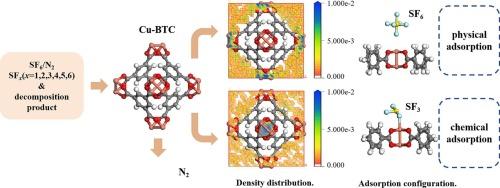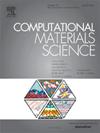Adsorption characteristics of Cu-BTC for trace SF6 and its fault decomposition products in SF6/N2 gas mixtures
IF 3.3
3区 材料科学
Q2 MATERIALS SCIENCE, MULTIDISCIPLINARY
引用次数: 0
Abstract
Replacing SF6 in existing gas-insulated equipment with SF6/N2 is an effective means of reducing SF6 use and emissions at this stage. This paper proposes the use of metal–organic skeleton material Cu-BTC for adsorption and separation of trace SF6 and its faulty decomposition products in SF6/N2 gas mixtures, in order to achieve the effective separation and purification and recovery of trace SF6 and its decomposition products in high-capacity SF6/N2 gases, and thus reduce the damage of SF6 and its decomposition products to the human environment. The results show that: the high specific surface area and three-dimensional microporous structure of Cu-BTC endowed it with excellent adsorption capacity, and the adsorption of SF6 reaches 4.6 mmol/g at 298 K and 100 bar, which is 7–9 times higher than that of the traditional molecular sieve (kdhF-03); the adsorption isotherms are in accordance with the characteristics of I-type, and the adsorption capacity decreases with the increase of temperature; CF4 exhibits the widest range of adsorption sites due to the molecular size fit to the secondary window; SF3 shows the highest adsorption activity due to the formation of chemical bonding (adsorption energy −1.375 eV) with the open metal site of Cu2+, whereas SO2 and H2S are directionally bonded to the Cu site through the sulphur atoms; the charge transfer and density of states analyses further reveal that the p-orbitals of the S, F atoms electronic coupling mechanism with Cu-BTC. This study provides a theoretical basis for the development of highly efficient SF6 adsorbent materials with potential applications in reducing greenhouse gas emissions in power equipment. Firstly, the adsorption performance of Cu-BTC on SF6 and its decomposition products (SO2F2, SOF2, SOF4, SO2, NF3, NO2, NO, N2O, HF, H2S and CF4) is systematically explored by using a grand canonical Monte Carlo method; and then, the parameters of adsorption energy, charge transfer and density of states of Cu-BTC for SF6 and its main fault decomposition gases are further analysed in conjunction with the density functional theory, so as to investigate the adsorption properties and mechanisms of different gas molecules in Cu-BTC.

Cu-BTC对SF6/N2混合气中微量SF6及其断层分解产物的吸附特性
用SF6/N2替代现有气体绝缘设备中的SF6是现阶段减少SF6使用和排放的有效手段。本文提出利用金属有机骨架材料Cu-BTC吸附分离SF6/N2混合气体中痕量SF6及其不良分解产物,以实现高容量SF6/N2气体中痕量SF6及其分解产物的有效分离纯化和回收,从而减少SF6及其分解产物对人类环境的破坏。结果表明:Cu-BTC的高比表面积和三维微孔结构使其具有优异的吸附能力,在298 K和100 bar条件下对SF6的吸附量达到4.6 mmol/g,是传统分子筛(kdhF-03)的7-9倍;吸附等温线符合i型特征,吸附量随温度升高而降低;由于CF4的分子大小适合于二级窗口,因此具有最宽的吸附位点范围;SF3与Cu2+的开放金属位形成化学键,吸附能为- 1.375 eV,而SO2和H2S则通过硫原子与Cu位定向键合,表现出最高的吸附活性;电荷转移和态密度分析进一步揭示了S、F原子的p轨道与Cu-BTC的电子耦合机制。本研究为开发高效SF6吸附材料提供了理论基础,在电力设备温室气体减排方面具有潜在的应用前景。首先,采用大规范蒙特卡罗方法系统探索Cu-BTC对SF6及其分解产物(SO2F2、SOF2、SOF4、SO2、NF3、NO2、NO、N2O、HF、H2S和CF4)的吸附性能;然后,结合密度功能理论,进一步分析Cu-BTC对SF6及其主要故障分解气体的吸附能、电荷转移和态密度参数,探讨不同气体分子在Cu-BTC中的吸附特性和机理。
本文章由计算机程序翻译,如有差异,请以英文原文为准。
求助全文
约1分钟内获得全文
求助全文
来源期刊

Computational Materials Science
工程技术-材料科学:综合
CiteScore
6.50
自引率
6.10%
发文量
665
审稿时长
26 days
期刊介绍:
The goal of Computational Materials Science is to report on results that provide new or unique insights into, or significantly expand our understanding of, the properties of materials or phenomena associated with their design, synthesis, processing, characterization, and utilization. To be relevant to the journal, the results should be applied or applicable to specific material systems that are discussed within the submission.
 求助内容:
求助内容: 应助结果提醒方式:
应助结果提醒方式:


